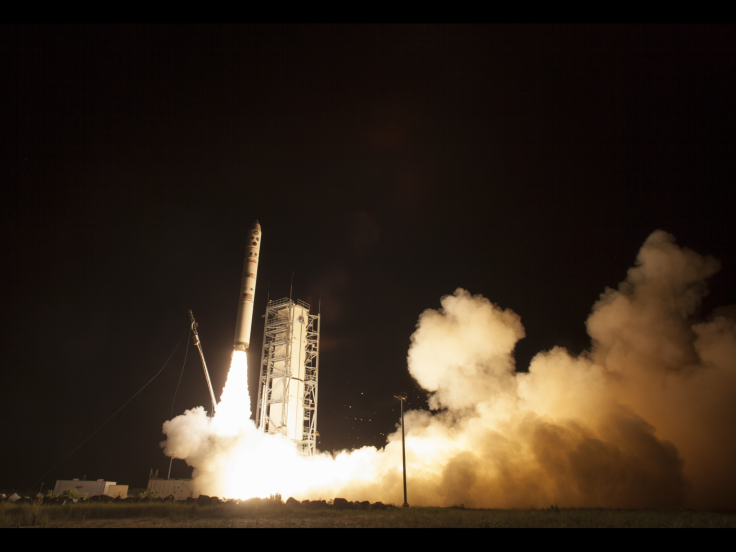NASA’s LADEE Launch Is A Success, What’s Next For The New Moon Probe?
Update: NASA states the reaction wheels are back on-line. According to the official statement, "NASA has confirmed that the reaction wheels of its Lunar Atmosphere and Dust Environment Explorer (LADEE) were successfully brought back on-line and the spacecraft has acquired its safe-mode attitude profile."
NASA’s LADEE spacecraft launch Friday night in Virginia was a success. The space agency’s new moon probe will observe the atmosphere of Earth’s natural satellite for approximately 160 days.

NASA’s Lunar Atmosphere and Dust Environment Explorer (LADEE) launched from Wallops Flight Facility, Va., at 11:27 p.m. EDT Friday. While the launch was considered a success, the space agency did note there was a technical issue as the spacecraft shut down its reaction wheels after separating from the launch vehicle. LADEE’s reaction wheels are used to stabilize the spacecraft and were turned on as it was spinning too fast after separating from the Minotaur V rocket, reports the Associated Press.
It is unclear why the spacecraft shut down its reaction wheels but Ames center director S. Pete Worden considers the situation a minor setback and said there is plenty of time to resolve any problems. “The LADEE spacecraft is communicating and is very robust. The mission team has ample time to resolve this issue before the spacecraft reaches lunar orbit. We don't have to do anything in a rush,” said Worden in a statement. LADEE is currently communicating with ground controllers, notes NASA.
After launch, LADEE’s team will analyze the spacecraft as part of a routine checkout and NASA may spend more time to figure out what caused LADEE to shut down its reaction wheels. Checkout, according to NASA, lasts anywhere from a day to a week.
The moon probe’s main objective is to study the lunar atmosphere and try to unravel the mystery of lunar dust. LADEE will spend the next 30 days getting to the moon and will then enter the lunar atmosphere. NASA has broken down the moon mission into eight phases, launch, ascent, activation and checkout, phasing orbits, lunar orbit insertion, commissioning, science and decommissioning. LADEE is currently in the activation and checkout phase and will shortly enter the phasing orbits phase.
Upon arriving at the moon, LADEE will go behind the moon and perform a "lunar orbit insertion" maneuver, reports NASA. LADEE will be in an elliptical retrograde equatorial orbit, traveling in the opposite direction of the moon’s orbit. It will take 24 hours for LADEE to complete an orbit around the moon. The spacecraft will perform another series of maneuvers that will create a circular orbit around the moon at an altitude of 156 miles (250 kilometers) above the moon’s surface. The orbiting altitude may vary due to the “lumpy” gravity of the moon, caused by mass concentrations created by asteroid impacts.
As part of the commission phase, which can last between 40 to 60 days, NASA will test out the Lunar Laser Communications Demonstration. The LLCD will determine the effectiveness of using laser communication to relay messages to Earth.
LADEE has several tools onboard that will be used during the science phase, which will last approximately 100 days. The Ultraviolet and Visible Light Spectrometer will study the moon’s atmosphere and determine its composition, notes NASA, while the Neutral Mass Spectrometer will measure any variations in the moon’s atmosphere.
The Lunar Dust Experiment will collect samples to learn more about the fine lunar dust that troubled astronauts and can damage equipment, reports Agence France-Presse. According to NASA, the LDEX will be used to determine if lunar dust was responsible for a “pre-sunrise horizon glow” observed by the Apollo 17 crew.
Learning more about the moon’s thin atmosphere, also known as a surface boundary exosphere, will help researchers learn more about the atmospheres of other planets. According to NASA, the moon’s exosphere may be the most common type of atmosphere found in our solar system and understanding it could yield new insights about the atmosphere of Mercury, larger asteroids or the moons orbiting Jupiter and Saturn. The new insights may also shed some light on the development of Mercury, Venus, Mars and Earth.
After completing the science phase, LADEE will enter the decommissioning phase where it will lower its orbiting altitude and will ultimately crash into the moon. A video of LADEE’s launch can be viewed below.
© Copyright IBTimes 2025. All rights reserved.






















